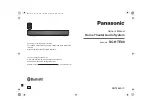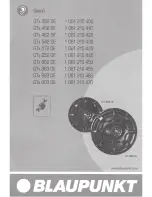44
Connections to the Fault Relay are made using the 2-pin Orange Phoenix connector designated R-Control. A separate
Fault Relay is needed for each 8-channel DSP controlled digital amplifier; an IC24A, for example, would have 3 Fault
relays.
To prevent contact wear, it is suggested that the input of the circuit used with the contacts have a 0.1µFd 50V or higher
capacitor connected between the leads of that input. In the case of multiple switches wired in a series or parallel connec-
tion to a single input, only one capacitor is needed.
The Fault Relay can be programed for one of 4 modes of operation using two programming jumpers each with two posi-
tions. J1 (jumper 1) has positions A and B while J3 has positions C and D. The four possible operation modes are:
1.
When the power is off, the contact is closed. When the power is turned on, the contact may open momentarily while the
unit does a self test then goes closed. The contact then goes open if that column faults out. The contact closes again if
the power is shut off. Combination BD
2.
When the power is off, the contact is open. When the power is turned on, the contact may close momentarily while the
unit does a self test then goes open. The contact then goes closed if that column faults out. The contact opens again if the
power is shut off. Combination BC
3.
When the power is off, the contact is closed. When the power is turned on, the contact changes to open. The contact
then goes closed if that column faults out or the power shuts off. Combination AD
4.
When the power is off, the contact is open. When the power is turned on, the contact changes to closed. The contact
then goes open if that column faults out or the power shuts off. Combination AC
Mode 3 is the most popular one and the one used on all orders unless another mode is requested. The operational mode
can be changed in the field by removing the side panel adjacent to the orange Phoenix connector and changing the
jumpers on the Fault Relay PC board.
INSTALLATION
General Information
Your Iconyx column array was designed to be easy to install on either a flat surface such as a wall or suspended from a
ceiling. Note that it was not designed to be mounted in the wall or in an alcove. The amplifers are convection cooled and
their heat sinks require at least an inch of separation from the nearest surface.
Optional hinge kits allow wall mounted column arrays to be rotated 90 degrees away from the wall to provide easy access
to the rear access ports during installation and for routine testing and service. They also provide the separation needed for
cooling.
The actual installation should be made either by or under the close supervision of someone experienced in installation
techniques and rigging.
Wall Mounting
The following instructions assume that the column array(s) will be mounted using Renkus-Heinz HK series hinge kits.
Unless the hinge kits were ordered separately from the column array(s) the female hinge sections and mounting plates will
already be attached to the column array.
Notice that each mounting plate has hinge sections on both the right and left side of the plate to provide for either “right” or
“left” swing away from the wall. IC8A, IC16A and IC16/8A column arrays will have two hinge sections; IC 24, IC32A and
IC32/16A column arrays will have three hinge sections.
Owners Manual


















